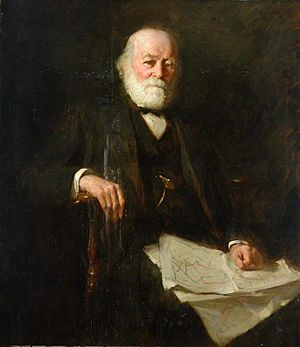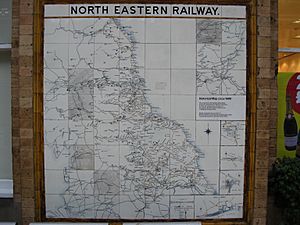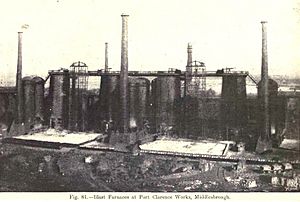Lowthian Bell facts for kids
Quick facts for kids
Sir Isaac Lowthian Bell, Bt
|
|
|---|---|

Sir Isaac Lowthian Bell, by Frank Bramley. National Railway Museum, York
|
|
| Born | 18 February 1816 Newcastle upon Tyne, England
|
| Died | 20 December 1904 (aged 88) London, England
|
| Occupation | Ironmaster, Company Director |
| Known for | Ironmaking, metallurgy, industrial chemistry Member of Parliament |
| Awards | Albert Medal (1895) |
Sir Isaac Lowthian Bell, 1st Baronet (born February 18, 1816 – died December 20, 1904) was a very important businessman and politician from the Victorian era. He lived in Washington, England. People said he was "as famous in his day as Isambard Kingdom Brunel", who was a famous engineer.
Bell was a very active and smart businessman. He was also a skilled metallurgist, which means he knew a lot about how metals behave. He worked with his brothers to make iron and chemicals. He also teamed up with other inventors, like Robert Stirling Newall, to make steel cables.
He was one of the first to make aluminium in large amounts at his factory in Washington. He also did experiments to make other chemicals, like the element thallium. He was a director for big companies, including the North Eastern Railway. He also worked for the company building the Forth Bridge, which was the biggest bridge project in the world at that time.
Sir Isaac was also rich and loved art. He hired famous artists and designers like Philip Webb, William Morris, and Edward Burne-Jones. They helped him decorate his large homes in Yorkshire, called Rounton Grange and Mount Grace Priory.
Contents
Early Life and Education
Isaac Lowthian Bell was born in Newcastle-upon-Tyne. His father, Thomas Bell, helped start a company that made iron and chemicals. Isaac went to school in Newcastle. Then, he studied science at Edinburgh University in Scotland and the Sorbonne University in Paris, France.
He learned about making chemicals in France. In 1836, he came back to Newcastle. He started working at his father's iron and chemical factory.
Building an Industry Empire

Sir Isaac Bell was involved in many businesses at the same time. This made his work life quite complicated. He wanted to be a successful businessman. So, when his father died in 1845, he took over the Walker ironworks.
In 1850, Bell made an important discovery in Washington. He found a new way to make a chemical called lead oxychloride. He started a chemical company with his brother-in-law, Robert Benson Bowman, and his father-in-law, Hugh Lee Pattinson. Pattinson was famous for inventing a way to separate silver from lead.
In 1850, Bell also partnered with Robert Stirling Newall. Together, they built the world's first factory to make steel rope and underwater cables using machines. Two years later, his brothers, Thomas and John, joined him. They built a large ironworks at Port Clarence, near Middlesbrough.
By 1853, their factory had three huge blast furnaces. These were the biggest in Britain at the time. They made iron for bridges and steel rails for railways. These rails were used all over the British Empire, including for the North Eastern Railway. Bell became a director of this railway company in 1864. He was also its deputy chairman from 1895 until he died.
The Bell brothers' company owned its own ironstone mines and limestone quarries. They employed about 6,000 people. By 1878, their company made 200,000 tons of iron every year. Bell was always trying new things. For example, he found ways to reuse heat from factory gases.
Making Aluminium and Thallium
In 1859, Bell opened Britain's first factory to make aluminium. This metal used to be as expensive as gold. This was because it was very hard to separate it from its raw materials. On the day the factory opened, Bell rode through Newcastle in his carriage. He wore an aluminium top hat to show off the new metal!
He explained that even tiny amounts of other materials could ruin aluminium. If it wasn't pure, it would lose its color and be hard to shape. This was especially true for making aluminium-bronze, which needed very pure aluminium to be useful.
In 1863, Bell showed off "several pounds" of a newly found element called thallium. This metal came from the waste products of making sulphuric acid at his Washington factory. A researcher named Henri Brivet, who worked in Bell's labs, helped discover it.
Improving Iron and Steel
The iron ore from Cleveland was not considered good for making steel. This was because it had a lot of phosphorus, which made the iron weak. Bell spent a lot of money on experiments. He found a way to make steel with very little phosphorus. This new process made strong steel rails.
Bell also remembered seeing wooden rails used to carry coal to the River Tees. This shows how much progress he brought to the industry.
In the late 1860s, Bell wrote papers comparing Britain's iron industry with other countries like France and Germany. Britain had excellent coal fields. But other countries, especially Germany, had cheaper workers.
In 1882, Bell found a large bed of salt deep underground at Port Clarence. He used this salt to make soda. Later, he sold the salt mine to another company.
By 1875, Bell started to step back from his daily work in the industry. He sold most of his shares in his manufacturing companies to a rival company in 1903. This made him even wealthier. He gave £5,000 to many of his nephews, nieces, and grandchildren.
Political Life
For 30 years, starting in 1850, Bell was active in the town council of Newcastle upon Tyne. He became the town's sheriff in 1851 and mayor in 1854. He was elected mayor again in 1862.
Bell was also elected as a Member of Parliament (MP). He represented North Durham in 1874 and The Hartlepools from 1875 to 1880.
Awards and Achievements
Sir Isaac Bell helped start the Iron and Steel Institute. He was its president from 1873 to 1875. In 1874, he received the first Bessemer Gold Medal. He became a Fellow of the Royal Society in 1874 for his important work in chemistry and metal studies.
He was known around the world for his scientific knowledge. He was asked to be a judge at big international exhibitions in Philadelphia (1876) and Paris (1878). He also became an honorary member of the American Philosophical Institution. In 1877, he founded the Institute of Chemistry of Great Britain.
In 1882, he became a director of the Forth Bridge company. This was the biggest bridge project in the world at that time. Bell became president of the Institution of Mechanical Engineers in 1884. He was made a baronet in 1885, which is a special honor from the King or Queen. His family motto became Perseverantia, meaning "perseverance."
He received the George Stephenson Medal in 1890 and the Telford Medal in 1895 for his important papers. In 1895, he also received the Albert Medal. This was for his great contributions to arts, manufacturing, and business through his metal research.
Important Writings
Bell wrote many papers about chemistry and how metals are made. In his book Iron Trade, he correctly predicted that Germany would become a bigger industrial producer than Britain. He tried to get the government to act to prevent this.
Some of his major works include:
- The Manufacture of Iron in connection with the Northumberland and Durham Coalfields (1863)
- On the Manufacture of Aluminium (1863, 1864)
- The Chemical Phenomena of Iron Smelting (1872)
- The Iron Trade of the United Kingdom Compared with that of the Other Chief Ironmaking Nations (1875)
- The Principles of the Manufacture of Iron and Steel (1884)
Family Life and Homes
On July 20, 1842, Isaac, who was known as Lowthian, married Margaret Pattinson. Her father was his business partner, Hugh Lee Pattinson. Margaret's younger sisters also married Bell's business partners.
Isaac and Margaret had several children, including Sir Thomas Hugh Bell, who became the 2nd Baronet. Their granddaughter was the famous explorer and diplomat Gertrude Bell. Isaac had about 60 grandchildren!
In 1854, he built a large house called Washington New Hall. In 1872, a young child working as a chimney sweep died in a chimney at the Hall. After this sad event, Bell moved to a newly built house called Rounton Grange. He later gave Washington Hall to be a home for poor children. He asked for it to be named "Dame Margaret's Hall" after his wife.
His granddaughter's biographer described him as a "formidable giant of a man" who could be a bit rough. His family even joked about him in a Christmas alphabet, calling him "the Crushing Contemptuous Pater" (father).

Rounton Grange was finished in 1876. It was a huge house with five floors, made of yellow brick. It had large chimneys and old-fashioned features. Inside, it had a huge arched hallway and a wide staircase. The main living room had two grand pianos. There was also a large tapestry designed by William Morris and Edward Burne-Jones. Lady Bell and her daughters made this tapestry over several years.
Even though he was very wealthy, Isaac and Margaret lived quite simply. They liked the Arts and Crafts style. He bought the old Mount Grace Priory in 1898 as a weekend home. It was in bad shape, but he spent three years fixing it up. The house was decorated by the best designers of the time, including William Morris.
Sir Isaac Lowthian Bell died on December 20, 1904, at his home in London. He left a large fortune to his son.
Legacy
After he died, the Institution of Mining Engineers said that it was "impossible to estimate the value of the services that Sir Lowthian Bell rendered" to them.
Gertrude Bell's biographer, Georgina Howell, said that Sir Isaac Bell was seen as the "high priest of British Metallurgy" because of his writings. She also noted his wealth and his new ideas, like using steel waste as fertilizer. She called him "arguably Britain's foremost industrialist." He was friends with famous Victorians like Charles Darwin and William Morris. However, Howell also wrote that Bell was "admired rather than loved" and seemed to be bossy with his family.


